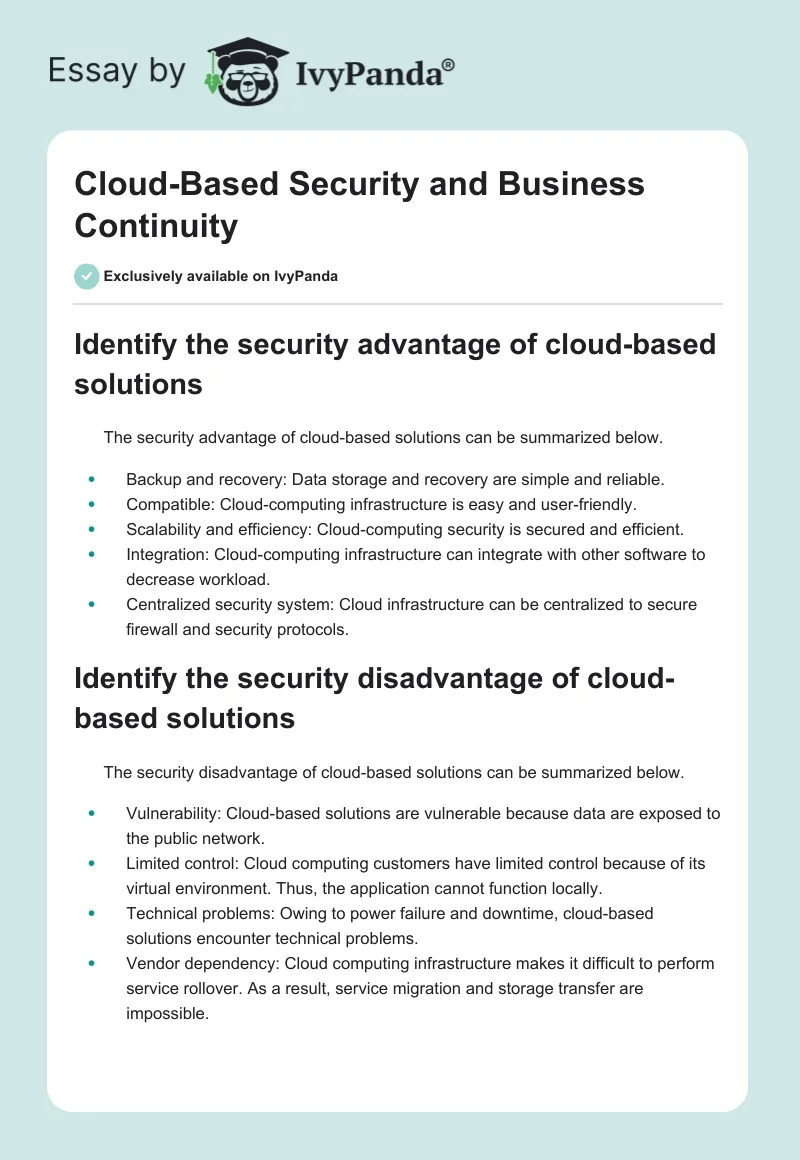Identify the security advantage of cloud-based solutions
The security advantage of cloud-based solutions can be summarized below.
- Backup and recovery: Data storage and recovery are simple and reliable.
- Compatible: Cloud-computing infrastructure is easy and user-friendly.
- Scalability and efficiency: Cloud-computing security is secured and efficient.
- Integration: Cloud-computing infrastructure can integrate with other software to decrease workload.
- Centralized security system: Cloud infrastructure can be centralized to secure firewall and security protocols.
Identify the security disadvantage of cloud-based solutions
The security disadvantage of cloud-based solutions can be summarized below.
- Vulnerability: Cloud-based solutions are vulnerable because data are exposed to the public network.
- Limited control: Cloud computing customers have limited control because of its virtual environment. Thus, the application cannot function locally.
- Technical problems: Owing to power failure and downtime, cloud-based solutions encounter technical problems.
- Vendor dependency: Cloud computing infrastructure makes it difficult to perform service rollover. As a result, service migration and storage transfer are impossible.
What is data wiping process?
Data wiping processes are used to erase data and confidential files. Most organizations use data wiping techniques during system upgrades and organizational change. The procedure eliminated unauthorized access to sensitive data saved in the system servers (Grinstein & Koch, 2005). However, it is not possible to retrieve data after completing data wipe processes.
What is hyperjacking attacks?
The disadvantage of a centralized data system is called hyperjacking. Hyperjacking attack is an act that changes the control protocol of the hypervisor. As a result, the attacker establishes a virtual environment called a rogue hypervisor to ensure complete control. Although hyperjacking is still a theoretical problem, it is difficult to ascertain a real situation (Grinstein & Koch, 2005). The reason is that the attacker can masquerade the rogue hypervisor without detection. However, the attacker must have access to the system server before the launch. Hyperjacking attacks can be eliminated using the secured management protocol and regular patching.
What is guest-hopping attacks?
A situation where the attacker penetrates two virtual machines is called a guest-hopping attack. For instance, if the attacker wants to control virtual machine X, the attacker will use virtual machine Y to gain access to virtual machine A. Thus, the attacker must identify both virtual machines before the attack.
Define business continuity and disaster recover? What is the difference?
The processes and procedures that ensure continuous operations during and after an attack are called business continuity. However, disaster recovery describes the methods of recovery after an induced or natural disaster (Kleyman, 2014). Disaster recovery techniques include server backups, branch protocol, and network regrouping. The difference between business continuity and disaster recovery is the steps taken to ensure recovery. Disaster recovery techniques are enforced after an attack, while business continuity procedures are utilized during the attack.
Identify the security advantage and disadvantage of adopting cloud-based back-up operations
The security advantages of cloud-based backup operations include scalability with savings, efficiency, reliability, recovery time, and accessibility. Cloud-based backup is accessible from any location provided an Internet connection is established. The time of recovery is lower compared to other backup operations. Cloud backup operations are effective and reliable. As a result, server visualization, encoding, decoding, and encryption are the basic features of cloud backup operations.
Identify the threats to an IT data center infrastructure and provide solutions to minimize the risk?
The major threat to an IT data center is the DDoS attack (Kleyman, 2014). As a result, most organizations incur high operational during and after the attack. DNS reflection is another threat to an IT data infrastructure. The sophistication of cloud attackers makes it easier to penetrate any server infrastructure within minutes. However, security providers have utilized several solutions to mitigate the threats on an IT data infrastructure. Some solutions include deploying virtual appliances, deep scanning, deploying layered security, and monitor algorithms.
References
Grinstein, G. & Koch, H. (2005). Switching probabilities for single-domain magnetic particles. Phys. Rev. B, 71(1), 184-427.
Kleyman, B. (2014). Understanding and mitigating risk from data center threats. Web.


